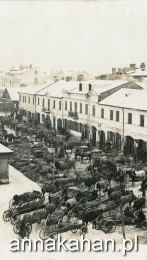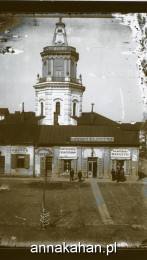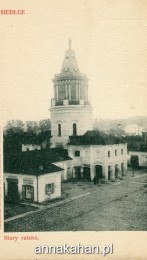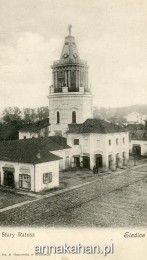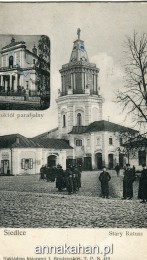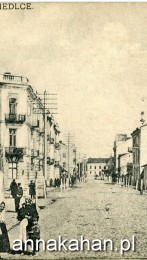[The Old Town Hall]
The most important building on the odd side of the former pedestrian zone “from the bell tower to the God’s house” is the Old Town Hall also known as “Jacek” (Jack).
Today, the building houses the Siedlce Regional Museum. It was established in 1928 as the Mieczysław Asłanowicz Museum of Podlasie and occupied only one room on the second floor, within the tower. Now, the museum’s library, which is considered the most beautiful in the region, is in its place.
In Poland, the town hall is also well known but for other reasons. It was the second building in its history, which was equipped with lightning protection system.
In the past, there were wooden buildings used as a town hall in this place; however, they were all destroyed by fires. The late-Baroque building was erected between 1763 and 1773, presumably designed by a prominent architect, Johann Sigmund Deybel, the same man who designed corner towers topped with a statue of Atlas in the Wilanów Palace. The construction was financed by Duchess Aleksandra’s parents, Eleonora of the Waldsteins and Michał Czartoryski. Thanks to Aleksandra Ogińska, the building was renovated several times, particularly focusing on its tower, which suffered extensive fire damage. Still, the Duchess never wanted to change the shape of the tower or the statue of Atlas on the roof.
The first statue of Atlas holding the world on his shoulders was probably placed on the top of tower in 1769. Initially Atlas stood facing the direction of Saint Stanislaus Bishop and Martyr’s Church, which means that he was looking towards the east. It is clearly visible in the iconography of the nineteenth century, which survived to this day. Then, in the era of photography, the statue was facing north, as it is now.
The location of the statue was once a subject of jokes. According to the residents of Siedlce, only Jack from the town hall tower had the courage to officially turn his back on the communist alliance, because next door there was a cinema called “Alliance”.
The origin of the town hall’s name “Jack” is still shrouded in mystery. According to the legend, the model who posed for the statue of Atlas was the Duchess’s equerry or a butler of imposing physique, named Jack. The other legend suggests that it was a very strong smith. Once he repaired the carriage of the Duchess. Raising the vehicle with one hand, he replaced the wheel with the other. The Duchess was delighted with his strength and decided to employ him.
In the long history of the Town Hall “Jack”, the building was used by different institutions, among them were, the Orthodox church, the Registrar’s Office, a municipal library, the Association of Secular Culture, the State Centre of Monument Research and Documentation, the Municipal Cultural Centre, and Monument Conservation Workshops. The building also housed service centres, which specialised in such forgotten professions as bicycle enamelling or razor sharpening.
The Town Hall building stands out not only owing to its exceptional architecture but also because of Michał Ogiński’s piano polonaise Farewell to the Homeland (Pożegnanie ojczyzny) that is heard from the tower every three hours.
The places you have just seen were very important for the city regarding the culture, heritage or the pragmatics of everyday life.
We pass the museum and go further on. We turn right. On our left, we pass the Old Church whereas on the right we leave the Regional Museum. After reaching Pułaski Street, we go further down Floriańska Street (previously 1st Tadeusz Kościuszki Division). We get to Sienkiewicz Street (previously Ogrodowa Street) and we turn right. On this street, famous Siedlce photographers had their premises. In her diary, Anna Kahan assesses the appearance of these two streets in the following way, “Both streets are nice, wide, and inhabited by many goys.” (Sunday, January 20, 1915).
